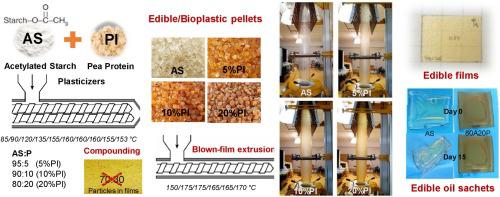当前位置:
X-MOL 学术
›
Food Packag. Shelf Life
›
论文详情
Our official English website, www.x-mol.net, welcomes your
feedback! (Note: you will need to create a separate account there.)
Effects of pea protein on properties of cassava starch edible films produced by blown-film extrusion for oil packaging
Food Packaging and Shelf Life ( IF 8.5 ) Pub Date : 2020-06-01 , DOI: 10.1016/j.fpsl.2020.100480 Kedpraveen Huntrakul , Rangrong Yoksan , Amporn Sane , Nathdanai Harnkarnsujarit
Food Packaging and Shelf Life ( IF 8.5 ) Pub Date : 2020-06-01 , DOI: 10.1016/j.fpsl.2020.100480 Kedpraveen Huntrakul , Rangrong Yoksan , Amporn Sane , Nathdanai Harnkarnsujarit

|
Abstract Starch can be commercially prepared into edible and biodegradable packaging via plasticization and extrusion. However, plasticized starch has poor stability in blown-film extrusion processability and storage properties which can be improved by combinations with protein. Edible films were developed from acetylated cassava starch (AS) and pea protein isolate (PI) using conventional blown-film extrusion. Films with PI up to 20 % were determined for physical, thermal and barrier properties and stability for oil packaging. PI stabilized films during blown-extrusion but decreased flexibility due to strong inter- and intra-molecular interaction with non-homogeneity of AS-PI blend matrices. Protein dispersed in AS matrices at low PI and formed continuous networks at 20 % which led to increased tensile strength. Increase in PI decreased solubility and light transmission but increased protein aggregation and improved crystallinity, surface hydrophobicity and barrier properties against water vapor and oxygen. Increase in PI also reduced glass transition and relaxation temperatures of AS-PI blends. Heat-sealed AS and AS-PI sachets showed effective protection for soybean and olive oil stored for 3 months at different humidities. PI blending effectively prevented humidity-induced shrinkage of AS film (up to 55 %) and enhanced polymer-glycerol interaction which improved thermal stability. Blending of starch and plant-derived pea protein effectively improved blown-film processability and barrier properties for oil-based food products.
中文翻译:

豌豆蛋白对吹膜挤压油包装木薯淀粉食用薄膜性能的影响
摘要 淀粉可通过塑化和挤出在商业上制备成可食用和可生物降解的包装。然而,增塑淀粉在吹膜挤出加工性和储存性能方面的稳定性差,这可以通过与蛋白质组合来改善。食用薄膜由乙酰化木薯淀粉 (AS) 和豌豆分离蛋白 (PI) 使用常规吹膜挤出制成。PI 高达 20% 的薄膜的物理、热和阻隔性能以及油包装的稳定性被确定。PI 在吹塑挤出过程中稳定了薄膜,但由于分子间和分子内的强相互作用以及 AS-PI 共混基质的非均质性而降低了柔韧性。蛋白质以低 PI 分散在 AS 基质中,并以 20% 的比例形成连续网络,从而提高拉伸强度。PI 的增加降低了溶解度和透光率,但增加了蛋白质聚集并提高了结晶度、表面疏水性和对水蒸气和氧气的阻隔性能。PI 的增加也降低了 AS-PI 共混物的玻璃化转变温度和弛豫温度。热封 AS 和 AS-PI 小袋对在不同湿度下储存 3 个月的大豆和橄榄油显示出有效保护。PI 共混有效地防止了 AS 薄膜的湿度引起的收缩(高达 55%)并增强了聚合物-甘油的相互作用,从而提高了热稳定性。淀粉和植物源豌豆蛋白的混合有效地改善了油基食品的吹膜加工性和阻隔性能。表面疏水性和对水蒸气和氧气的阻隔性能。PI 的增加也降低了 AS-PI 共混物的玻璃化转变温度和弛豫温度。热封 AS 和 AS-PI 小袋对在不同湿度下储存 3 个月的大豆和橄榄油显示出有效保护。PI 共混有效地防止了 AS 薄膜的湿度引起的收缩(高达 55%)并增强了聚合物-甘油的相互作用,从而提高了热稳定性。淀粉和植物源豌豆蛋白的混合有效地改善了油基食品的吹膜加工性和阻隔性能。表面疏水性和对水蒸气和氧气的阻隔性能。PI 的增加也降低了 AS-PI 共混物的玻璃化转变温度和弛豫温度。热封 AS 和 AS-PI 小袋对在不同湿度下储存 3 个月的大豆和橄榄油显示出有效保护。PI 共混有效地防止了 AS 薄膜的湿度引起的收缩(高达 55%)并增强了聚合物-甘油的相互作用,从而提高了热稳定性。淀粉和植物源豌豆蛋白的混合有效地改善了油基食品的吹膜加工性和阻隔性能。热封 AS 和 AS-PI 小袋对在不同湿度下储存 3 个月的大豆和橄榄油显示出有效保护。PI 共混有效地防止了 AS 薄膜的湿度引起的收缩(高达 55%)并增强了聚合物-甘油的相互作用,从而提高了热稳定性。淀粉和植物源豌豆蛋白的混合有效地改善了油基食品的吹膜加工性和阻隔性能。热封 AS 和 AS-PI 小袋对在不同湿度下储存 3 个月的大豆和橄榄油显示出有效保护。PI 共混有效地防止了 AS 薄膜的湿度引起的收缩(高达 55%)并增强了聚合物-甘油的相互作用,从而提高了热稳定性。淀粉和植物源豌豆蛋白的混合有效地改善了油基食品的吹膜加工性和阻隔性能。
更新日期:2020-06-01
中文翻译:

豌豆蛋白对吹膜挤压油包装木薯淀粉食用薄膜性能的影响
摘要 淀粉可通过塑化和挤出在商业上制备成可食用和可生物降解的包装。然而,增塑淀粉在吹膜挤出加工性和储存性能方面的稳定性差,这可以通过与蛋白质组合来改善。食用薄膜由乙酰化木薯淀粉 (AS) 和豌豆分离蛋白 (PI) 使用常规吹膜挤出制成。PI 高达 20% 的薄膜的物理、热和阻隔性能以及油包装的稳定性被确定。PI 在吹塑挤出过程中稳定了薄膜,但由于分子间和分子内的强相互作用以及 AS-PI 共混基质的非均质性而降低了柔韧性。蛋白质以低 PI 分散在 AS 基质中,并以 20% 的比例形成连续网络,从而提高拉伸强度。PI 的增加降低了溶解度和透光率,但增加了蛋白质聚集并提高了结晶度、表面疏水性和对水蒸气和氧气的阻隔性能。PI 的增加也降低了 AS-PI 共混物的玻璃化转变温度和弛豫温度。热封 AS 和 AS-PI 小袋对在不同湿度下储存 3 个月的大豆和橄榄油显示出有效保护。PI 共混有效地防止了 AS 薄膜的湿度引起的收缩(高达 55%)并增强了聚合物-甘油的相互作用,从而提高了热稳定性。淀粉和植物源豌豆蛋白的混合有效地改善了油基食品的吹膜加工性和阻隔性能。表面疏水性和对水蒸气和氧气的阻隔性能。PI 的增加也降低了 AS-PI 共混物的玻璃化转变温度和弛豫温度。热封 AS 和 AS-PI 小袋对在不同湿度下储存 3 个月的大豆和橄榄油显示出有效保护。PI 共混有效地防止了 AS 薄膜的湿度引起的收缩(高达 55%)并增强了聚合物-甘油的相互作用,从而提高了热稳定性。淀粉和植物源豌豆蛋白的混合有效地改善了油基食品的吹膜加工性和阻隔性能。表面疏水性和对水蒸气和氧气的阻隔性能。PI 的增加也降低了 AS-PI 共混物的玻璃化转变温度和弛豫温度。热封 AS 和 AS-PI 小袋对在不同湿度下储存 3 个月的大豆和橄榄油显示出有效保护。PI 共混有效地防止了 AS 薄膜的湿度引起的收缩(高达 55%)并增强了聚合物-甘油的相互作用,从而提高了热稳定性。淀粉和植物源豌豆蛋白的混合有效地改善了油基食品的吹膜加工性和阻隔性能。热封 AS 和 AS-PI 小袋对在不同湿度下储存 3 个月的大豆和橄榄油显示出有效保护。PI 共混有效地防止了 AS 薄膜的湿度引起的收缩(高达 55%)并增强了聚合物-甘油的相互作用,从而提高了热稳定性。淀粉和植物源豌豆蛋白的混合有效地改善了油基食品的吹膜加工性和阻隔性能。热封 AS 和 AS-PI 小袋对在不同湿度下储存 3 个月的大豆和橄榄油显示出有效保护。PI 共混有效地防止了 AS 薄膜的湿度引起的收缩(高达 55%)并增强了聚合物-甘油的相互作用,从而提高了热稳定性。淀粉和植物源豌豆蛋白的混合有效地改善了油基食品的吹膜加工性和阻隔性能。









































 京公网安备 11010802027423号
京公网安备 11010802027423号